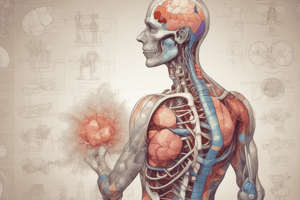Podcast
Questions and Answers
What is the primary role of calcitriol in calcium absorption?
What is the primary role of calcitriol in calcium absorption?
- Decreases calcium absorption by renal interference
- Competes with other minerals for intestinal absorption
- Enhances the synthesis of calcium-binding transport proteins (correct)
- Inhibits the solubility of calcium in the gut
Which factor is known to inhibit calcium absorption?
Which factor is known to inhibit calcium absorption?
- Vitamin D
- Protein
- Phytate (correct)
- Lactose
What percentage of calcium in the blood is typically bound to proteins?
What percentage of calcium in the blood is typically bound to proteins?
- 20%
- 10%
- 50%
- 40% (correct)
Which of the following substances enhances calcium absorption?
Which of the following substances enhances calcium absorption?
How does excessive magnesium intake affect calcium absorption?
How does excessive magnesium intake affect calcium absorption?
What percentage of calcium in the human body is found in bones and teeth?
What percentage of calcium in the human body is found in bones and teeth?
Which mechanism relies on energy in the absorption of calcium?
Which mechanism relies on energy in the absorption of calcium?
Which of the following factors can improve calcium absorption?
Which of the following factors can improve calcium absorption?
Which of the following vegetables is a poor source of calcium due to the presence of oxalic acid?
Which of the following vegetables is a poor source of calcium due to the presence of oxalic acid?
What is the primary location for active transport of calcium in the digestive system?
What is the primary location for active transport of calcium in the digestive system?
What effect does parathyroid hormone (PTH) have on calcium levels in the blood?
What effect does parathyroid hormone (PTH) have on calcium levels in the blood?
How does calcitonin affect osteoclast activity?
How does calcitonin affect osteoclast activity?
Which hormone increases the absorption of calcium in the intestines?
Which hormone increases the absorption of calcium in the intestines?
What role does calcitriol play in calcium balance?
What role does calcitriol play in calcium balance?
What is the relationship between calcitonin and parathyroid hormone?
What is the relationship between calcitonin and parathyroid hormone?
Which site is NOT one of the primary sites of calcium regulation in the body?
Which site is NOT one of the primary sites of calcium regulation in the body?
What is a primary function of calcium in the body?
What is a primary function of calcium in the body?
What effect does vitamin D have on osteoblasts?
What effect does vitamin D have on osteoblasts?
What happens to renal excretion of calcium when PTH is released?
What happens to renal excretion of calcium when PTH is released?
What effect does calcitonin have on renal calcium excretion?
What effect does calcitonin have on renal calcium excretion?
Flashcards
Calcium's Role in the Body
Calcium's Role in the Body
Calcium is the most abundant mineral in the body, found mainly in bones and teeth as hydroxyapatite. A small amount is present in body fluids.
Food Sources of Calcium
Food Sources of Calcium
The best sources of calcium are milk and dairy products, including cheese and yogurt. Salmon and sardines (with bones) are also good options. Some vegetables, like broccoli and cauliflower, provide decent amounts.
Calcium Absorption Mechanisms
Calcium Absorption Mechanisms
Calcium is absorbed in the small intestine through two main processes: active transport and passive transport.
Active Calcium Transport
Active Calcium Transport
Signup and view all the flashcards
Passive Calcium Transport
Passive Calcium Transport
Signup and view all the flashcards
Vitamin D and Calcium Absorption
Vitamin D and Calcium Absorption
Signup and view all the flashcards
Phytate and Calcium Absorption
Phytate and Calcium Absorption
Signup and view all the flashcards
Calcium Transport in Blood
Calcium Transport in Blood
Signup and view all the flashcards
Phosphorus and Calcium Absorption
Phosphorus and Calcium Absorption
Signup and view all the flashcards
Estrogen and Calcium Absorption
Estrogen and Calcium Absorption
Signup and view all the flashcards
What is parathyroid hormone (PTH)?
What is parathyroid hormone (PTH)?
Signup and view all the flashcards
What is calcitonin?
What is calcitonin?
Signup and view all the flashcards
How does PTH affect calcium absorption in the intestines?
How does PTH affect calcium absorption in the intestines?
Signup and view all the flashcards
How does PTH affect bone calcium?
How does PTH affect bone calcium?
Signup and view all the flashcards
How does PTH influence calcium excretion by the kidneys?
How does PTH influence calcium excretion by the kidneys?
Signup and view all the flashcards
How does calcitonin affect bone calcium?
How does calcitonin affect bone calcium?
Signup and view all the flashcards
How does calcitonin influence calcium excretion by the kidneys?
How does calcitonin influence calcium excretion by the kidneys?
Signup and view all the flashcards
How does calcitriol (active vitamin D) affect calcium absorption in the intestines?
How does calcitriol (active vitamin D) affect calcium absorption in the intestines?
Signup and view all the flashcards
How does calcitriol affect bone calcium?
How does calcitriol affect bone calcium?
Signup and view all the flashcards
What are the main functions of calcium in the body?
What are the main functions of calcium in the body?
Signup and view all the flashcards
Study Notes
Minerals in the Human Body
- Minerals are essential nutrients, crucial for various bodily functions. Numerous minerals (Ca, Mg, Co, K, Si, Cr, Zn, Mo, Na, Mn, Se, Cu, P, I, Fe, S) are required in varying amounts.
Average Amounts of Minerals in Adults
- Charts show average amounts of various minerals in the adult human body.
- This data ranges from grams for major minerals like calcium (1200g) to milligrams for trace minerals like manganese (12-20mg).
Calcium
- Calcium is the most abundant mineral in the body.
- Approximately 99% of body calcium is stored in bones and teeth.
- The remaining 1% is distributed in intracellular and extracellular fluids, and found in its ionic form in body fluids.
Calcium Sources
- The best calcium sources include dairy products (milk, yogurt, cheese) and certain sea foods (salmon, sardines with bones).
- Vegetables like broccoli and cauliflower are also good sources.
- Fortified foods and calcium supplements provide additional sources.
Calcium Absorption
- Calcium is primarily present in ionic form, and also in protein and insoluble salts (like calcium carbonate and calcium citrate)
- Some calcium is released from these salts at acidic pH (similar to that of the stomach) before absorption.
- Stomach acid assists in calcium release to improve absorption.
- Solubilization does not automatically lead to better absorption. Free calcium can bind, reducing bioavailability.
- Absorption occurs mostly in the small intestine, via two primary mechanisms:
- Active transport (transcellular): occurs in the duodenum and jejunum, needs energy (ATP) and involves calcium-binding proteins (CBP), stimulated by calcitriol (active vitamin D).
- Passive transport (paracellular): occurs in the jejunum and ileum, does not require energy; more effective with higher calcium intake.
Factors Affecting Calcium Absorption
- Growth, pregnancy, and lactation: Significantly increase calcium requirements and improve absorption. Growing children absorb up to 75% of dietary calcium while adults have an average of around 30% absorption.
- Calcitriol (vitamin D3): Aids in synthesis of calcium-binding transport protein, essential for transporting calcium into cells; thus improving calcium absorption. Decreased renal calcitriol occurs with age, reducing absorption.
- Vitamin D synthesis: UV light from the sun assists in production of vitamin D in the skin. Dietary vitamin D from sources like fatty fish, meat, supplements, is processed further through liver and kidney to become physiologically active calcitriol.
- Dietary factors:
- Lactose intake enhances calcium absorption (increases solubility).
- Protein intake aids calcium absorption.
- Phytate (contained in some fibers) inhibits calcium absorption. Calcium and phytate ratio greater than 0.2:1 decreases availability
- High fiber intake may also bind calcium, reducing absorption.
- Oxalate chelates calcium, lowering solubility and increasing fecal calcium excretion.
- Excess magnesium: Magnesium and calcium compete for intestinal absorption, affecting absorption.
- Unabsorbed dietary fatty acids: (steatorrhea) interfere with calcium absorption, forming insoluble calcium soaps.
- Phosphorus: High levels of phosphorus reduce calcium absorption.
- Sodium and caffeine: High levels of sodium and caffeine increase urinary calcium excretion, potentially impairing calcium balance.
- Iron: Increased calcium intake decreases non-heme iron absorption.
- Lead: Reduced calcium intake increases lead absorption.
- Estrogen: Estrogen deficiency, such as at menopause, may lead to reduced vitamin D-mediated calcium absorption.
Calcium Transport
- Approximately 50% of blood calcium is free (ionized). This is the physiologically active form.
- Approximately 10% of blood calcium is bound to anions like sulfate, phosphate, or citrate; which is diffusible.
- Approximately 40% of blood calcium is bound to protein (mainly albumin), rendering it non-diffusible.
Total Calcium Distribution
- 99% of calcium exists in bones (hydroxyapatite structure).
- 1% of calcium is distributed throughout the body.
Calcium Homeostasis
- Parathyroid hormone (PTH), calcitonin, and vitamin D work together in a feedback loop to maintain calcium homeostasis. The three key organs in this process are intestine, bone, and kidneys
Regulation of Blood Calcium Levels
- Calcitriol (vitamin D): Increases absorption of calcium in intestinal mucosa.
- Vitamin D: Also acts independently on bone to increase osteoblast activity and numbers
- Parathyroid Hormone (PTH): released when calcium levels fall, which increases calcium levels by increasing calcium reabsorption in the kidneys, stimulating bone resorption (release of calcium into the bloodstream), increasing calcium absorption in the intestines.
- Calcitonin: Released when calcium rises too high in the blood. Lowers calcium levels by slowing bone resorption and promoting calcium excretion.
Functions of Calcium
- Bone mineralization and maintenance
- Muscle contraction
- Secretion of hormones (insulin, PTH, calcitonin)
- Activation of enzymes (like kinases needing calmodulin)
- Blood coagulation
Calcium Imbalances
- Hypercalcemia: Blood calcium is above 11 mg/dL, caused by hyperparathyroidism, hypervitaminosis D or hypothyroidism.
- Hypocalcemia: Blood calcium is below 8.8 mg/dL, caused by hypoparathyroidism, surgical removal of parathyroid glands, hyperthyroidism, renal failure, vitamin D deficiency, or low protein diet, If below 7.5mg/dL, tetany may result.
Calcification
- Calcium buildup in tissue, blood vessels, or organs. This hardening can disrupt normal bodily functions. Calcification can occur nearly anywhere in the body given the transport of calcium to the relevant portions through the blood stream.
Causes of Calcification
- Infections
- Calcium metabolism disorders causing hypercalcemia
- Genetic or autoimmune disorders affecting the skeletal or connective tissues
- Persistent inflammation
Calcium Deficiency
- Inadequate calcium intake
- Poor calcium absorption
- Excessive calcium losses
Calcium Deficiency Diseases
- Rickets (children)
- Osteoporosis (adults)
Calcium Relationship with Other Diseases
- Hypertension: Inverse relationship between calcium intake and blood pressure. (Lower calcium intake increases hypertension)
- Colon cancer: Calcium may decrease colon cancer risk by binding and increasing excretion of bile acids.
- Obesity: Low calcium intake associated with obesity and high body weights. High calcium intake modulates fat metabolism with decreased fat synthesis and more fat breakdown
Studying That Suits You
Use AI to generate personalized quizzes and flashcards to suit your learning preferences.




